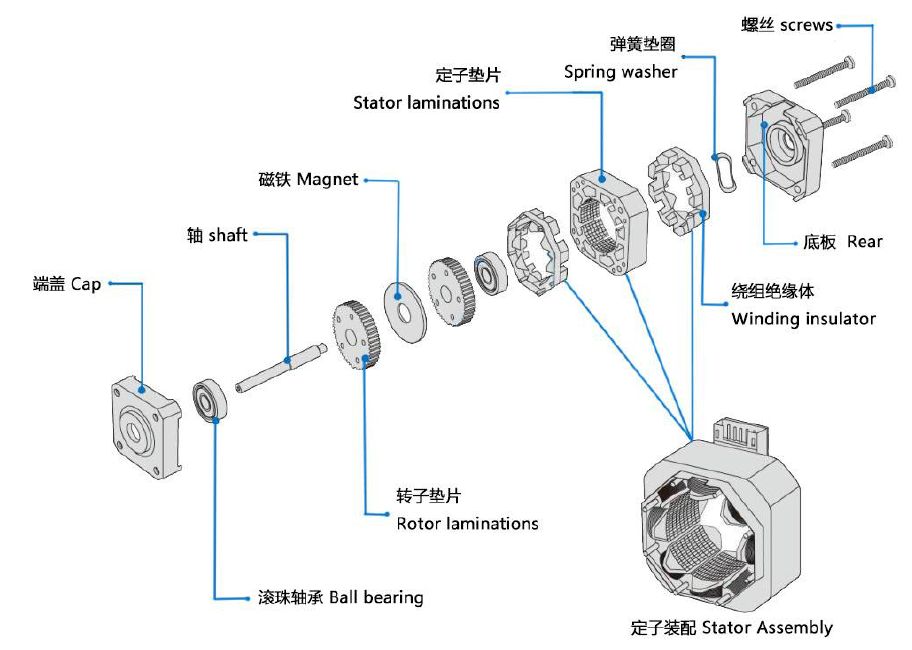There is a big difference between a motor and an electric motor. Today we will look at some of the differences between the two and further distinguish the differences between them.
What is an electric motor?
An electric motor is an electromagnetic device that converts or transmits electrical energy according to the laws of electromagnetic induction.
A motor is represented by the letter M in the circuit (D in the old standard) and its main function is to produce driving torque as a power source for appliances or various machines, while a generator is represented by the letter G in the circuit and its main function is to convert electrical energy into mechanical energy.
一. Motor division and classification
1. According to the type of working power supply: can be divided into DC motor and AC motor.
2. According to the structure and working principle, it can be divided into DC motor, asynchronous motor and synchronous motor.
3. According to the starting and running mode: capacitor starting single-phase asynchronous motor, capacitor running single-phase asynchronous motor, capacitor starting and running single-phase asynchronous motor and split-phase single-phase asynchronous motor.
4. According to the purpose, the motor can be divided into: motor for driving and motor for control.
5. According to the structure of the rotor: cage induction motor (old standard called squirrel cage induction motor) and wound rotor induction motor (old standard called wound asynchronous motor).
6. According to the speed of operation, they can be divided into: high-speed motors, low-speed motors, constant-speed motors and speed-controlled motors. Low-speed motors are divided into gear motors, electromagnetic reduction motors, torque motors and claw-pole synchronous motors.
二. What is an electric motor
An electric motor (Motor) is a device that converts electrical energy into mechanical energy. It is the use of energized coils (also known as stator windings) to generate a rotating magnetic field and act on the rotor (such as squirrel cage closed aluminum frame) to form a magnetoelectric power rotating torque. Electric motors are divided into DC motors and AC motors according to the power source used. Most electric motors in power systems are AC motors, which can be synchronous or asynchronous (the motor stator magnetic field speed and rotor rotation speed do not maintain synchronous speed). An electric motor consists mainly of a stator and a rotor. The direction of movement of an energised wire in a magnetic field is related to the direction of the current and the direction of the magnetic induction lines (magnetic field direction). The working principle of the motor is that the magnetic field acts as a force on the current, causing the motor to rotate.
三、The basic structure of electric motor
1. The structure of a three-phase asynchronous motor consists of a stator, a rotor and other accessories.
2. The DC motor has an octagonal, fully laminated structure with series excitation winding, which is suitable for automatic control technology where forward and reverse rotation is required. They can also be made with series-excited windings according to customer requirements. Motors with a centre height of 100 to 280 mm have no compensation winding, but motors with a centre height of 250 mm and 280 mm can be made with compensation winding according to specific conditions and needs, and motors with a centre height of 315 to 450 mm have compensation winding. The dimensions and technical requirements of motors with a centre height of 500-710mm are in accordance with IEC international standards, and the mechanical dimensional tolerances of the motors are in accordance with ISO international standards.
Is there any difference between a motor and an electric motor?
Electric motors include both motors and generators. It is a general term for generators and motors, and the two are conceptually distinguished by the difference. An electric motor is only one of the modes of operation of a motor, but it operates in electric mode, which means that electrical energy is converted into other forms of energy; the other mode of operation of a motor is a generator, which operates in power generation mode, converting other forms of energy into electrical energy. However, certain motors such as synchronous motors are generally more often used as generators, but can also be used directly as electric motors. Asynchronous motors are more often used as electric motors, but, with the addition of simple peripheral components, can also be used as generators.
Post time: Aug-14-2023

